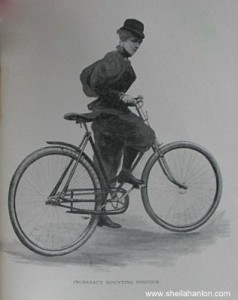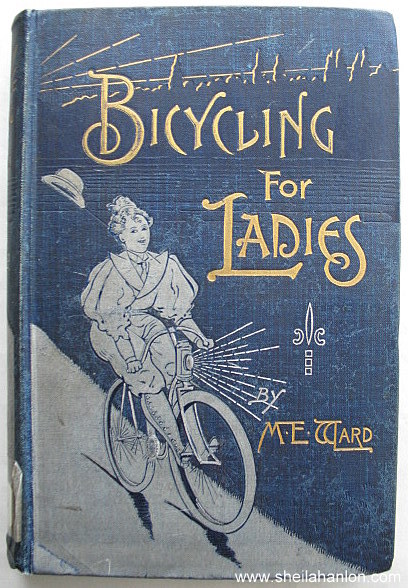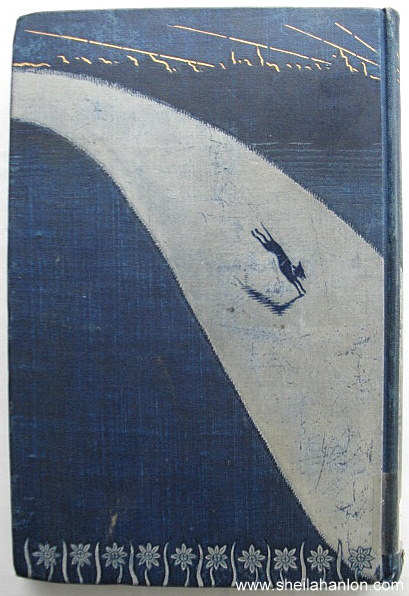In 1896, Maria E Ward published a comprehensive instruction manual aimed at women interested in cycling. Her book, Bicycling for Ladies, shown above, was one of many similar titles published in the cycle craze era. Ward’s liberated approach, however, made her book stand out among its rivals.
Bicycling for Ladies was a catch all guide to cycling covering everything from choosing a bicycle and learning to ride to health and dress. What distinguished Ward’s manual from the wider genre of women’s cycling instruction, the majority of which was aimed at leisure riders and focused on genteel riding etiquette, was its attention to mechanical detail. Among its more forward thinking chapters were “Women and Tools” and “Mechanics of Bicycling.” Ward’s objective was to emancipate her lady cyclist readers by teaching them the “laws of mechanics and physiology.”
Ward explained her approach in the introduction to “Women and Tools,” writing, “Most women can sew on a button or run up a seam; sewing, in fact, is regarded rather as a feminine in-stinct than an art…I hold that any woman who is able to use a needle or scissors can use other tools equally well. It is a very important matter for a bicyclist to be acquainted with all parts of the bicycle, their uses and adjustment. Many a weary hour would be spared were a little proper attention given at the right time to your machine.”
 Another clue that this manual was for advanced cyclists comes from its cover. The blue and gold embossed book features a bold lady cyclist scorching down a curvaceous country lane. Her legs are thrust out forward and her feet balanced on pegs attached to the hub of the front wheel to keep them free of the spinning peddles as she flies downhill. Her hat flies off behind her as a further indicator of the delirious speed she has reached. The rider sports the rational cycling costume that Ward endorsed and which was associated with the New Womanly lady cyclist. The scenic backdrop, setting sun, and glowing lamp light suggests our rider is taking her leisure on a lonely rural road in the evening, a habit that was not endorsed for lady riders.
Another clue that this manual was for advanced cyclists comes from its cover. The blue and gold embossed book features a bold lady cyclist scorching down a curvaceous country lane. Her legs are thrust out forward and her feet balanced on pegs attached to the hub of the front wheel to keep them free of the spinning peddles as she flies downhill. Her hat flies off behind her as a further indicator of the delirious speed she has reached. The rider sports the rational cycling costume that Ward endorsed and which was associated with the New Womanly lady cyclist. The scenic backdrop, setting sun, and glowing lamp light suggests our rider is taking her leisure on a lonely rural road in the evening, a habit that was not endorsed for lady riders.
The country road cuts elegantly across the spine of Bicycling for Ladies and continues on the back cover. Note the little dog scampering down the lane in the image below. (And also the self portrait of this historian’s hand in the photo above.)
Bicycling for Ladies is also of note for the number and quality of images of women-a-wheel it contains.  A flip through the book reveals ample illustrations showing how to, and how not to, ride a bicycle. Ward hired gymnast Daisy Elliot to demonstrate cycling techniques such as how to mount, dismount, carry a bicycle, and perform basic maintenance. Alice Austen, a friend of Ward’s and resident of of Staten Island, photographed the model in various correct and incorrect cycling poses in her studio. Illustrations were then created for the book based on these images. For the final images, Elliot’s face was rendered softer and prettier, since the gymnast’s well muscled physique and plain features were considered unseemly.
A flip through the book reveals ample illustrations showing how to, and how not to, ride a bicycle. Ward hired gymnast Daisy Elliot to demonstrate cycling techniques such as how to mount, dismount, carry a bicycle, and perform basic maintenance. Alice Austen, a friend of Ward’s and resident of of Staten Island, photographed the model in various correct and incorrect cycling poses in her studio. Illustrations were then created for the book based on these images. For the final images, Elliot’s face was rendered softer and prettier, since the gymnast’s well muscled physique and plain features were considered unseemly.
The preface of Bicycling for Ladies, reproduced below, provides further insight into Ward’s philosophy of women’s cycling. It also hints at some of the challenges faced by the pioneering lady cyclists of the 1890s.
I HAVE found that in bicycling, as in other sports
essayed by them, women and girls bring upon them-
selves censure from many sources. I have also
found that this censure, though almost invariably
deserved, is called forth not so much by what they
do as the way they do it.
It is quite natural to suppose, in attempting an
unaccustomed exercise, that you have to do only
what you see done and as others about you are do-
ing. But to attain success in bicycling, as in other
things, it is necessary to study the means as well as
to look to the end to be attained, and to understand
what must not be attempted as well as to know each
step that will be an advance on the road to progress.
A great deal has been said against attempting to
study a little of anything; but when a slight knowl-
edge of several important branches of science that
bear directly upon a subject under consideration,
and that a subject concerning the health and safety
of many individuals, will render one intelligently
self-dependent, and able at least to exercise without
endangering one's own health or the lives of others,
the acquisition of such knowledge should not be neg-
lected.
There are laws of mechanics and of physiology
that directly concern the cyclist; it has been the
author's aim to point out these laws, showing, for
instance, the possible dangers of exercise, and how
they may be avoided by the application to bicycle
exercise of simple and well-known physiological
laws, thus enabling the cyclist to resist fatigue and
avoid over-exertion. The needs of the bicyclist are
an intelligent comprehension of the bicycle as a ma-
chine, an appreciative knowledge of the human ma-
chine that propels it, and a realization of the fact
that rider and bicycle should form one combined
mechanism. For this, a knowledge of the laws that
determine the limits and possibilities of both me-
chanisms is necessary. The cyclist is limited, not
only by laws physiological and laws mechanical,
which determine when and for how long he may
travel, but he is restricted by the laws and ordinances
of county, town and village as to how and where he
may travel. A knowledge of these laws is lalso
necessary.
While not attempting to treat any of these subjects
exhaustively, the author has endeavored to place
them comprehensively before her readers, hoping to
prepare the enthusiast to enjoy all the delights of the
sport, to encourage the timid, and to assist the in-
experienced to define and determine existing limita-
tions. The subject of the care of the bicycle has
been carefully treated, some of the means at hand
suggested, and the necessary tool^gnd their uses ex-
plained. Other topics considered are how the bicy-
cle is propelled, and why it maintains its balance;
what the cyclist should learn, how correct form may
be attained and faults avoided, and what should be
the essential features of the clothing worn.
- Maria Ward, 1896
Sources:
Images: Photographed by Sheila Hanlon from original held at The Women’s Library, 2011
ME Ward, Bicycling for Ladies. Bretano: Washington & Paris, 1896.
Julie Wosk, Women and The Machine: Representations from the Spinning Wheel to the Electronic Age. London & Baltimore: The Johns Hopkins Press, 2003.








Pingback: Bikeleague.org Blog » Blog Archive » Women’s (Bike) History: Maria Ward